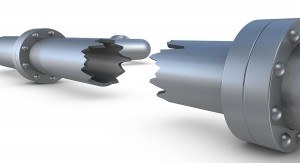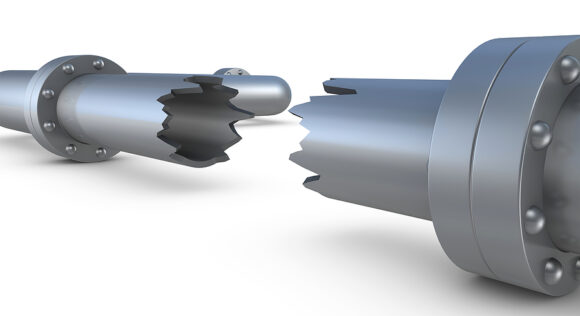 A 1/8-inch crack in a pipe can spew up to 250 gallons of water a day, causing substantial damage to surrounding property.
A 1/8-inch crack in a pipe can spew up to 250 gallons of water a day, causing substantial damage to surrounding property.
Establishing the cause of the rupture and gathering supporting documentation early in an investigation can assist an adjuster in the prompt resolution of the claim, said Thomas A. Mierzwa, a forensic civil structural engineer with LWG Consulting, during a recent webinar on the subject.
Some potential causes for a pipe rupture include physical damage, age, condensation, temperature-related stress and material failure, Mierzwa said.
Because a pipe rupture can occur in a number of areas within a home or building, the LWG forensic structural engineer recommends investigating the following when a loss involving a ruptured pipe or unexplained water damage is submitted:
- Interior supply piping
- Interior drain piping
- Exterior supply piping
- Exterior drain piping
- Water heaters
- Water filtration systems
- HVAC systems
- Fire suppression systems
In addition, in the case of a frozen pipe, adjusters should check home thermostats to make sure the temperature setting was at a minimum 55 degrees prior to the loss and should consider the distance between the pipe and walls to evaluate insulation issues.
Understanding the kinds of piping found in both residential and commercial settings can assist adjusters in identifying the cause of a rupture. Most pipes for residential commercial use for supply lines are copper, according to Mierzwa.
There are three grades of copper pipes used in supply lines:
- M is a thin grade wall pipe mainly used inside homes
- L is a medium grade pipe used outside by municipalities and water plants
- K is a thicker pipe used as water lines and between meters for commercial municipal applications
“Copper shouldn’t be installed if water in the area generally has a PH of 6.5 or less because it will cause corrosion and weakening of the pipe which is not typically desired,” Mierzwa said.
To avoid corrosion, the majority of public utilities try to keep a PH level somewhere between 7.2 and 8.0.
CPVC pipes are made of durable, off-white or yellow plastic and can be used for both hot and cold applications. They are corrosion resistant, according to Mierzwa, though not as tough as copper.
ABS pipes are used for non-pressure systems and drain applications. Besides being susceptible to UV ray degradation, some issues with the use of this pipe can include an improperly used sealant and a weakening of the pipe (seen as slight sag) if not supported properly, Mierzwa said.
PEX piping is made of cross link polyethylene that is flexible, non-corrosive and freeze resistant. This piping, seen in newer homes, can be used for radiant heating systems. The inlets or bends must be at 90 degree angles; if not, can lead to possible damage to the piping and the potential for detachment. Mierzwa recommended reviewing the instructions to ensure that installation guidelines were followed.
Galvanized steel pipes are typically used in fire suppression systems and have a 40 year life span. According to Mierzwa, a typical issue involves mismatched brass and copper valves that can lead to corrosion due to a chemical attack.
No longer used, polybutylene pipes were discontinued because pronounced leakage occurred as a result of their use, the LWG forensic structural engineer said. An adjuster can tell a polybutylene pipe by its black or gray color and because it will feel stiff and brittle. These pipes were used in homes built between 1970 and 1995.
Kitec, made of aluminum and a brass alloy, is a multi-pressure pipe that used to be on the market. The problem, said Mierzwa, is that the alloy – a combination of copper and zinc – contained too much zinc and the PH and hard waters would lead to a chemical reaction that corroded the pipe. The result is a white material that can clog and weaken other fittings.
He recommended reviewing several building and installation codes that may apply to a ruptured pipe claim. These include:
- American Society for Testing and Materials (ASTM) standards on use and construction and testing of pipe
- ASTM A53M relates to the pipe specifications
- American Society of Mechanical Engineers/American National Standards Institute (ASME/ANSI) B 16 identify the standards and fittings for piping systems
- National Fire Protection Association (NFPA) 25 describes the inspection and testing of fire suppression systems
- NFPA 13r provide sprinkler standards, including residential installation requirements
- International Building Code, International Organization for Standardization (IBC, ISO) TC138 applies to plastic pipes, fittings and valves for the transport of fluids
When responding to a pipe failure timing is everything, according to Mierzwa. The adjuster or retained engineer handling the claim needs to document the scene.
The adjuster should also obtain other supporting documentation including building plans or schematics and incident reports or logs kept by a commercial business or industrial plant.
“The logs will typically include water pressure measurements before and after the event,” Mierzwa said.
In addition, an adjuster should request documentation for any work completed and testing and installation done on or near the affected pipe.
Evidence, such as the pipe cutout, should be retained at a secure location with the appropriate chain of custody documented, Mierzwa said.
Was this article valuable?
Here are more articles you may enjoy.


 Survey Shows Distracted Drivers Overconfident: 20% Text While Driving, 15% Use Social Media
Survey Shows Distracted Drivers Overconfident: 20% Text While Driving, 15% Use Social Media  In Fight Over Insurance, Neighbors Crowdsource LA Fire Contamination Data
In Fight Over Insurance, Neighbors Crowdsource LA Fire Contamination Data  La Niña’s End Threatens to Unleash an Active Atlantic Hurricane Season
La Niña’s End Threatens to Unleash an Active Atlantic Hurricane Season  FEMA Denies Washington State Disaster Relief From Bomb Cyclone, Governor Says
FEMA Denies Washington State Disaster Relief From Bomb Cyclone, Governor Says 